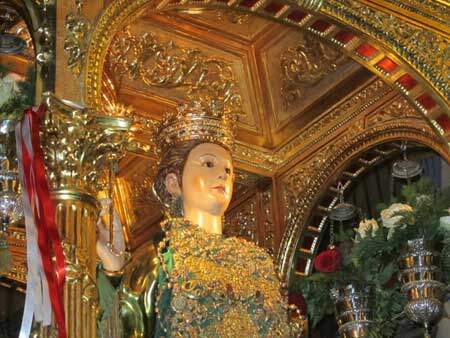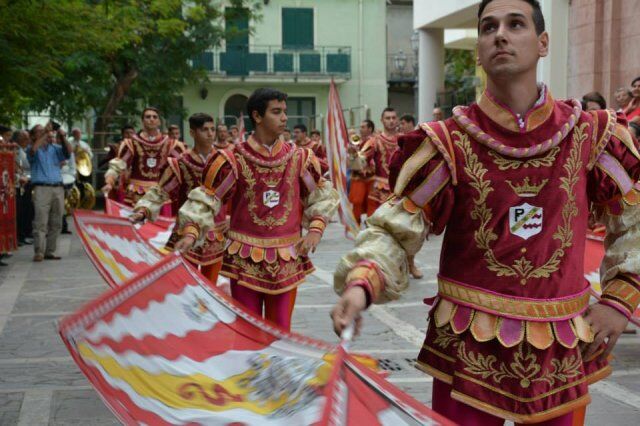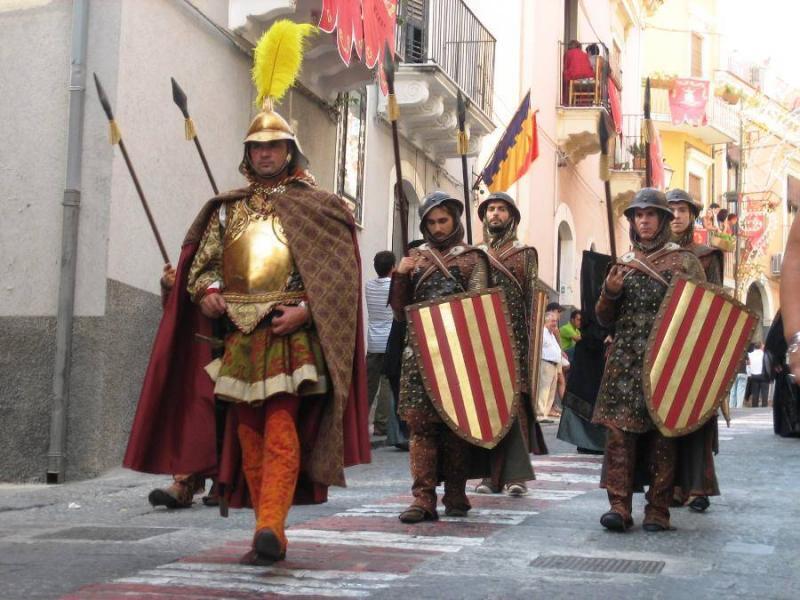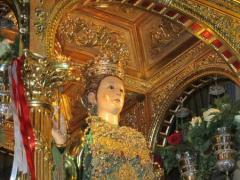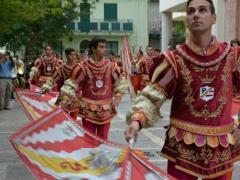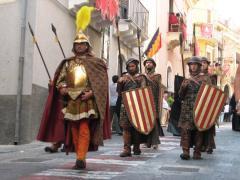Feast of Saint Anastasia
Street View (if present)
Street View is only available with Google Maps.
Description
Feast of Saint Anastasia
Property included in the Register of Intangible Heritage of Sicily (REIS)
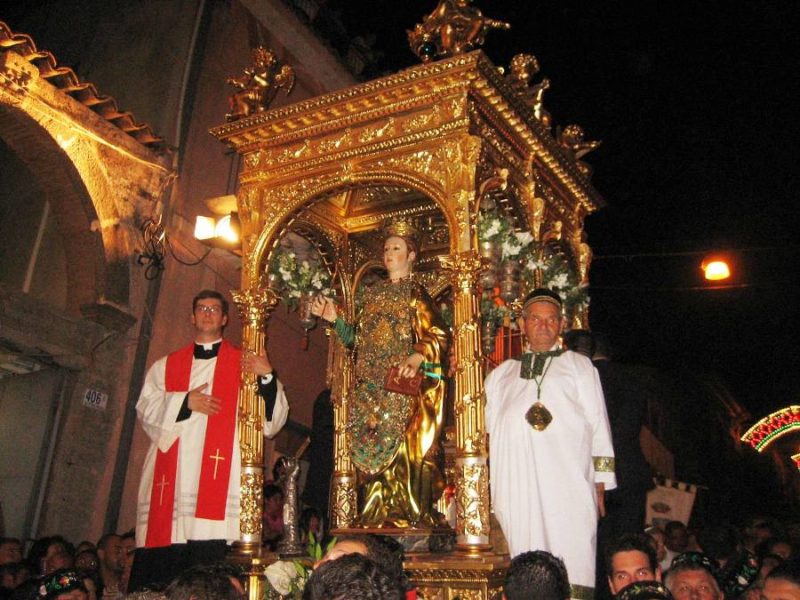
----------------
Technical sheet prepared by: Region of Sicily - Department of cultural heritage and Sicilian identity - CRicd: Regional center for inventory, cataloging and documentation and Sicilian regional film library
N. Prog. 100
Well: Feast of Santa Anastasia
Book: REI - Book of celebrations
Approval date: 16-11-2007
Category: Patronal feast
Province: Catania
Municipality: Motta Sant'Anastasia
Local denomination: Ranni party
Chronological News
Historical sources testify that religious events in honor of St. Anastasia date back to the 900s, when two groups of people, belonging to different classes, fought for the supremacy in animating the city life of the country and the success of religious events for the Saint. The parties in question were the "Party of the Campagnoli" and the "Party of the Masters". The first, born in 1820, included the peasant class, from which, in 1883, the "Panzera Party" was born following an internal split. The second, born in 1860, was made up of workers and artisans. The parties carried out an educational function for the younger generations and invited savings so that large sums could be reached to honor and pay homage to the Saint. Later the parties were called "Rioni", according to which the town was and is divided: to the north the "Maestri" district, the "Campagnoli" in the center and the "Panzera" district to the south.
The feast occurred on the day of the martyrdom of the Saint, December 25, but the locals decided to honor her on August 23-24-25 because at that time the crops in the fields facilitated the finding of funds for the celebrations.
Recurrence: Quadrennial
Date: 23-24-25 August
Occasion: Celebrations in honor of the patron saint
Function: Devotional
Actors: The active part in the festival are the "Parties", today called "Rioni", who perform in a predetermined order. The first is that of the “Young Masters”, in white and blue, followed by the “Vecchia Matrice” district, recognizable by the yellow and green colors and, finally, the “Panzera” district, in white-red colors.
The clergy and Catholic organizations, brotherhoods, flag-wavers and the Party Commission assist in the organization of the feast.
Participants: Local community, tourists
Description
La Ranni party, as the celebrations for Sant'Anastasia are defined, it takes place every four years from 23 to 25 August.
Day 23 the cannon shots remind the citizens of the beginning of the celebrations for the Santuzza. The day is characterized by the traditional offering of wax to the Patron, preceded by the procession with the “Cerei dei Rioni”. For the official opening of the celebrations it is necessary to wait until the afternoon of the same day, when the traditional descent of the "Quatrains" takes place, banners that carry the insignia of all the districts, symbolizing their participation in the festival. The procession of the districts follows, accompanied by a torchlight procession that frames the choreography and scenes inspired by the martyrdom of the Roman Virgin. The line ends with the spectacle of the flag-wavers, who join the procession once it has reached Piazza Umberto. In the evening it is the turn of the evocative procession in the presence of all the Catholic organizations, the members of the Confraternities dressed in traditional dress and the civil and military authorities.
Day 23 the cannon shots remind the citizens of the beginning of the celebrations for the Santuzza. The day is characterized by the traditional offering of wax to the Patron, preceded by the procession with the “Cerei dei Rioni”. For the official opening of the celebrations it is necessary to wait until the afternoon of the same day, when the traditional descent of the "Quatrains" takes place, banners that carry the insignia of all the districts, symbolizing their participation in the festival. The procession of the districts follows, accompanied by a torchlight procession that frames the choreography and scenes inspired by the martyrdom of the Roman Virgin. The line ends with the spectacle of the flag-wavers, who join the procession once it has reached Piazza Umberto. In the evening it is the turn of the evocative procession in the presence of all the Catholic organizations, the members of the Confraternities dressed in traditional dress and the civil and military authorities.
At the end of the procession, it is not unusual to meet those who, out of devotion, walk the streets of the procession to honor their vow promise through u travel.
On 24 August around 10:00, in the Mother Church crowded with faithful in an attitude of expectation, the solemn ceremony of the "opening" of the room that contains the simulacrum with the relics and the fercolo of the Santuzza. This, adorned with jewels and precious objects, turns with a placid gaze to the people of the faithful to bless them. In the afternoon of the same day the simulacrum, with the relics of the Saint, will be placed on the artistic fercolo, preceded by the "Cerei". The moving cry echoes in the streets: "Citizens, all citizens!", Followed by the choir "Viva Sant'Anastasia".
On the last day of the festivities, on the 25th, dawn is greeted by the sound of the bells that commemorate the martyrdom of the Saint. In the evening, after the solemn celebration presided over by the Archbishop of Catania, around 20:00, the statue of the Saint walks through the streets of the city in procession making a long stop in the square of the Panzera district where a particular arch is raised and where performances recalling the life of the Saint are performed.
The celebrations end with the spectacular fireworks that, in a bright game, cover the sky with colorful shooting stars. Tradition has it that these, dissolving, would like to mysteriously rejoin the fire of the martyrdom of St. Anastasia and the myth of the resurrection to new life.
On the last day of the festivities, on the 25th, dawn is greeted by the sound of the bells that commemorate the martyrdom of the Saint. In the evening, after the solemn celebration presided over by the Archbishop of Catania, around 20:00, the statue of the Saint walks through the streets of the city in procession making a long stop in the square of the Panzera district where a particular arch is raised and where performances recalling the life of the Saint are performed.
The celebrations end with the spectacular fireworks that, in a bright game, cover the sky with colorful shooting stars. Tradition has it that these, dissolving, would like to mysteriously rejoin the fire of the martyrdom of St. Anastasia and the myth of the resurrection to new life.
REFERENCES
Burgaretta, Sebastian. 2005. Travel Notes. Folklore, history and religiosity in Sicily. Syracuse: Emanuele Romeo Publisher.
Currents, Saints. 2015. Unusual guide to the mysteries, secrets, legends and curiosities of Sicily. Rome: Newton Compton.
Footnotes
Wooden works of various sizes, the "Candelore" or "Cerei" derive from the devotional offering of wax. In Sicilian Baroque style, they are made of decorated and gilded wood. With a weight that varies between 400 and 900 kilos, the candelore are carried on the shoulders of men, bud, which move them forward with one step and one vintaged characteristic.
Among the candelore that of the "Panzera" district. The "Cereo", built in sturdy oak wood, is 3 meters and 90 centimeters high and is made up of four orders. The first order is characterized by four columns that support the upper floors and by panels decorated with figurative medallions. In the second, four angels are depicted praising the devotion to the Holy Martyr. The scene is correlated with four panels depicting the Patron Saint and her martyrdom, Sant'Agata and the Immaculate Virgin. The glory and the coronation of the Holy Virgin Martyr Anastasia are represented on panels of chiseled wood in Baroque style, in the third and fourth order. Above dominates U Mazzu, the bouquet of flowers, or a composition of flowers created by florist artists of the district. At the top stands an order of flags.
Author Profile: Francesca Maria Riccobene
Go to Google Maps
Send a notice to the publisher
[contact-form-7 id="18385"]

